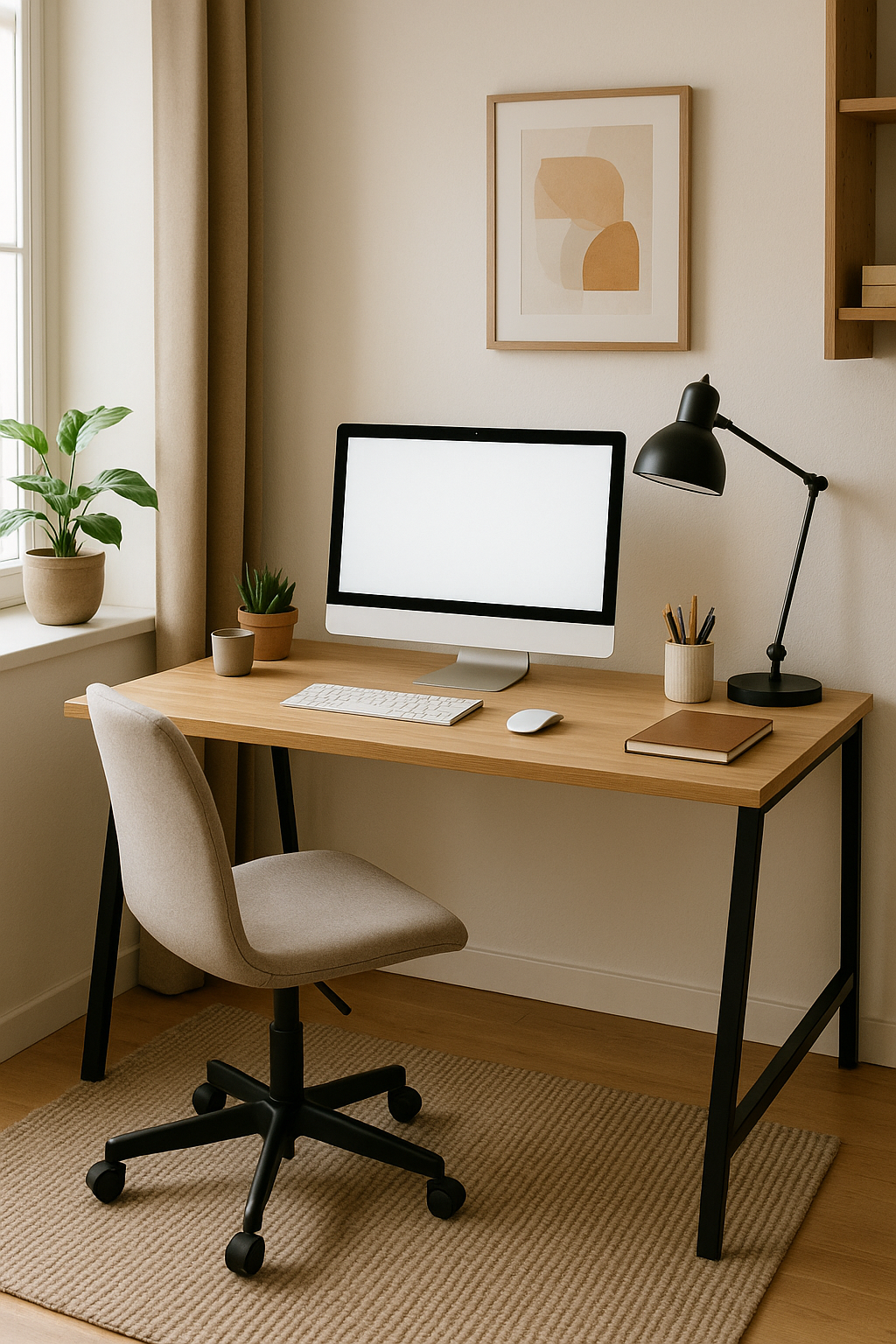Working from home offers freedom, but it also presents challenges—especially when it comes to comfort and focus. Whether you’re in a small apartment or a shared space, it’s possible to transform even the tiniest corner into a comfortable and productive home office.
This guide explores practical, stylish, and affordable ways to create a home workspace that supports your well-being and helps you get more done.
1. Choose the Right Spot
The first step to a productive office is finding the right location.
Ideal locations:
- Near a window for natural light
- Away from distractions, like the TV or kitchen
- Near outlets for easy tech access
- With good airflow and room to move
Even if you’re working with a corner of your bedroom or living room, prioritize a location where you can focus.
2. Invest in an Ergonomic Chair
You spend hours sitting—your chair should support your body.
Look for:
- Adjustable height and lumbar support
- Cushioned seat and breathable material
- Proper posture alignment (knees at 90°, feet flat)
If space or budget is limited, use a dining chair with a lumbar pillow and seat cushion for better ergonomics.
3. Upgrade Your Desk (or DIY One)
The right desk enhances posture and workflow.
Options:
- A standing desk or adjustable converter
- A wall-mounted desk in tight spaces
- A fold-out table that doubles as a dining or craft area
Ideal desk height is about 75 cm (29.5 in). Make sure your screen is at eye level and arms are parallel to the desk when typing.
4. Optimize Lighting
Bad lighting causes eye strain and fatigue. Good lighting improves both mood and productivity.
Tips:
- Use natural light as your main source
- Add a task lamp with warm white light (3000–4000K)
- Avoid glare by placing lights to the side, not behind your screen
Consider smart bulbs to adjust brightness and warmth throughout the day.
5. Declutter Your Space
Clutter is the enemy of concentration. Keep your workspace clean and intentional.
Organize:
- Use trays or drawer organizers for small items
- Store rarely-used supplies in bins or cabinets
- Go digital with notes and documents to reduce paper clutter
Clear space = clear mind.
6. Personalize with Purpose
Your office should reflect your personality—but keep decor simple and inspiring.
Add:
- A framed quote or photo
- A small plant or vase
- A soft rug underfoot
- Artwork that energizes you
Choose just a few meaningful pieces so it feels cozy but not crowded.
7. Use Sound to Focus
Noise can break your flow—but the right sounds can help you stay on task.
Try:
- Noise-canceling headphones
- White noise or nature sounds
- Instrumental music or productivity playlists
Apps like Noisli or Brain.fm are designed to improve concentration.
8. Maintain Good Air Quality
Fresh air = fresh thinking. Improve air circulation in your workspace.
Use:
- Air purifiers or fans
- Open windows when possible
- Indoor plants like snake plant, pothos, or peace lily
Good ventilation reduces fatigue, headaches, and distractions.
9. Create Zones for Work and Breaks
Even in a small apartment, you can mentally separate work from rest.
Set up:
- A primary desk or table for work
- A chair or floor cushion nearby for breaks or reading
- A timer to structure work sessions and pauses
Work in focused bursts, then step away to reset.
10. Add a Footrest or Floor Mat
Your legs need support, especially if you sit for long hours.
Try:
- A footrest or small box under your desk
- An anti-fatigue mat if using a standing desk
- A soft rug for comfort and warmth
Keeping feet elevated promotes better circulation.
11. Use Efficient Cable Management
Tangled cords are distracting and messy.
Solutions:
- Cable sleeves or clips
- Under-desk trays for power strips
- Wireless accessories (mouse, keyboard, charger)
A tidy desk looks better and feels better to work at.
12. Set Up Dual Monitors or Device Stands
If your work involves multitasking, having the right tech layout saves time.
Options:
- Dual monitors for designers, analysts, or developers
- A laptop stand + wireless keyboard setup
- A tablet stand for side references or creative work
This reduces neck strain and improves efficiency.
13. Keep Essential Tools Within Reach
Avoid interruptions by keeping everyday items nearby.
Keep at your fingertips:
- Pens and notepad
- Chargers and headphones
- Water bottle and snacks
- A blanket or hoodie if your space gets chilly
This reduces distractions and encourages longer focus sessions.
14. Establish Rituals to Start and End Work
Routine helps reinforce the mental shift between home and work—even in the same space.
Ideas:
- Start with coffee, music, or lighting a candle
- End by closing your laptop, tidying up, or writing tomorrow’s to-do list
- Use scent or light changes to mark the transition
This helps create healthy work boundaries.
15. Stay Flexible and Evolve Over Time
Your needs will change—your workspace should too.
Revisit regularly:
- Is your chair still comfortable?
- Does your lighting still work for the season?
- Are you still focused in this location?
Small adjustments (a new pillow, a plant, a shelf) can refresh your space and mindset.
Making your home office comfortable and productive is less about size—and more about intention. With the right chair, lighting, layout, and atmosphere, even a small space can become a powerful place to create, think, and work.
Don’t wait for the “perfect” setup. Start with what you have, make thoughtful upgrades, and turn your corner of the home into a space that works for you.

